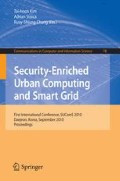Abstract
Most augmented reality (AR) applications in prepared environments implement illumination mechanisms between real and synthetic objects to achieve best results. This approach is beneficial to tracking technologies since additional visual cues provide seamless real-synthetic world integration. This research focuses on providing a projective illumination technique to aid augmented reality tracking technologies that work in unprepared environments where users are not allowed to modify the real environment, such as in outdoor applications. Here, we address the specific aspects of the common illumination problems such as efficient update of illumination for moving objects and camera calibration, rendering, and modeling of the real scene. Our framework aims to lead AR applications in unprepared environments with projective illumination regardless of the movement of real objects, lights and cameras.
Access this chapter
Tax calculation will be finalised at checkout
Purchases are for personal use only
Preview
Unable to display preview. Download preview PDF.
References
Azuma, R.: A survey of augmented reality. Presence: Teleoperators and Virtual Environments 6, 335–385 (1997)
State, A., Hirota, G., Chen, D., Garrett, B., Livingston, M.: Superior augmented reality registration by integrating landmark tracking and magnetic tracking. In: Proceedings of SIGGRAPH 1996, pp. 429–438 (1996)
Neumann, U., Cho, Y.: A self-tracking augmented reality system. In: Proceedings of ACM Virtual Reality Software and Technology, pp. 109–115 (1996)
Feiner, S., MacIntyre, B., Hollerer, T.: A touring machine: prototyping 3D mobile augmented reality systems for exploring the urban environment. In: Proceedings of First International Symposium on Wearable Computers, pp. 74–81 (1997)
Fournier, A., Gunawan, A.S., Romanzin, C.: Common illumination between real and computer generated scenes. In: Proceedings of Graphics Interface 1993, pp. 254–262. Morgan Kaufmann, San Francisco (1993)
Debevec, P.E., Malik, J.: Recovering high dynamic range radiance maps from photographs. In: Proceedings of SIGGRAPH 1997, pp. 369–378 (1997)
Drettakis, G., Robert, L., Bougnoux, S.: Interactive common illumination for computer augmented reality. In: Eurographics Rendering Workshop 1997, pp. 45–56 (1997)
Robert, L.: Camera calibration without feature extraction. Computer Vision, Graphics, and Image Processing 63(2), 314–325 (1995)
Tsai, R.Y.: A versatile camera calibration technique for high accuracy machine vision metrology using off-the-shelf TV cameras and lenses. IEEE Journal of Robotics and Automation 3(4), 323–344 (1987)
Debevec, P.: Rendering synthetic objects into real scenes: Bridging traditional and image-based graphics with global illumination and high dynamic range photography. In: Proceedings of SIGGRAPH 1998, pp. 189–198 (1998)
Heidrich, W., Seidel, H.P.: Realistic, hardware-accelerated shading and lighting. In: Proceedings of SIGGRAPH 1999, pp. 171–178 (1999)
Nakamae, E., Harada, K., Ishizaki, T., Nishita, T.: A montage method: The overlaying of the computer generated images onto a background photograph. In: Computer Graphics Proceedings of SIGGRAPH 1986, vol. 20(4), pp. 207–214 (1986)
Author information
Authors and Affiliations
Editor information
Editors and Affiliations
Rights and permissions
Copyright information
© 2010 Springer-Verlag Berlin Heidelberg
About this paper
Cite this paper
Cagalaban, G., Kim, S. (2010). Projective Illumination Technique in Unprepared Environments for Augmented Reality Applications. In: Kim, Th., Stoica, A., Chang, RS. (eds) Security-Enriched Urban Computing and Smart Grid. SUComS 2010. Communications in Computer and Information Science, vol 78. Springer, Berlin, Heidelberg. https://doi.org/10.1007/978-3-642-16444-6_3
Download citation
DOI: https://doi.org/10.1007/978-3-642-16444-6_3
Publisher Name: Springer, Berlin, Heidelberg
Print ISBN: 978-3-642-16443-9
Online ISBN: 978-3-642-16444-6
eBook Packages: Computer ScienceComputer Science (R0)

